Taking a user experience approach to envision how Ai tools can improve everyday activities.

For most of our semester in this course, we spent time dreaming, analyzing, and creating ways people interact with AI on grand scales. In this assignment, I wanted students to consider how AI could impact seemingly inconsequential, daily moments. I wanted us to explore: what will the “everyday” be like when AI is “everywhere”?
This in-class activity lasted three class periods where, in each class meeting, students mapped out an interaction with AI during a different time of day: morning, afternoon, and night. Students paired up with another student and shared everyday moments. The activity took place on a Miro whiteboard so everyone could see each other’s work in real-time. Here’s the assignment from our Canvas course.
Let’s Discover How AI Can Improve Everyday Life
We just finished exploring huge questions about how AI can impact the future and shape our communities globally. We’ve been dreaming huge. We have explored alternate realities. We have grabbed a telescope to the future and looked to the very edge of our imaginations. Now let’s realtor in a little to the very personal. AI will impact every corner of society, and our futures may look very different than today’s; most likely, it will be a part of our everyday lives in small ways. This activity will explore ways that AI could improve a single day. By focusing on one day, we may string together a month or even a year of improved personal experiences.
What’s Due?
| What | Format | Where | Who |
|---|---|---|---|
| Three New Everyday frames in Miro: Morning, Afternoon, and Night. | Miro | he New Everyday S24 Miro Board. To complete the turn-in, post anything in the Text Entry area on this Canvas assignment page. | Everyone |
| Three cards posted to the World Map and Day Timeline Frames. | Miro | The New Everyday S24 Miro Board. To complete the turn-in, post anything in the Text Entry area on this Canvas assignment page. | Everyone |
Why Are We Doing This?
Examining a single day focuses on where small means could be met using AI tools. This kind of focus will enable you to carefully analyze where needs are hiding and where design could meet those needs on a personal level.
Specifications
This activity counts as a Methods assignment. Power up!
Learning Outcomes
Strive to produce work that is Successful for each learning outcome.
- Align AI Outcomes With Stakeholder Needs: Use generative AI tools to create outcomes that match stakeholder needs.
- Anticipate AI Consequences: Analyze AI’s intended and unintended consequences at varying scopes.
- Use AI Ethically: Demonstrate ethical use of generative AI tools.
This assignment will be complete and count toward your final grade if the work accomplishes all learning outcomes. There is no partial credit.
Parameters
We will do this assignment together in class over the final two weeks of the semester. All of the work for this assignment will be completed in The New Everyday Miro board. This is a collaborative assignment where each student will be paired with another in our class to discuss their experiences. We will work together as a class to examine content posted to the Miro board, and we’ll analyze this content for themes that may reveal where AI tools can be most beneficial in improving everyday experiences.
This project involves three phases, all hosted in our Miro Board. During each phase, students will pair up to interview one another and share their daily experiences. This content will be entered into our Miro board on three frames.
Morning, Afternoon, Night Frames
Each of these frames contains prompts that will walk student pairs through identifying an activity, location and time where it took place, pain points, touchpoints, and prospective AI tools to improve the experience. Students will also identify intended and unintended consequences that may arise from implementing AI tools. These frames are the main turn-in for this assignment. They will guide student prayer discussions and our whole class discussion about AI in our everyday lives.
World Map and Day Timeline Frames
The activities we identify for this assignment may not occur in Oxford, Ohio. They can take place anywhere on Earth. If a learner in our course wants to pick an experience from Bali, Oklahoma City, or Antarctica, go for it! A card for each morning, afternoon, and night activity will be posted on the world map on our Miro board to show where this occurred. An identical card will also be posted to the date timeline so we can tell what time of day each of these activities took place.
For Miro Board work: Post a text entry in this Canvas assignment that the work is ready and turned in on time. Thanks! 👌
Execution Level
Shoot for completing this work at or beyond the level indicated below.

Refined Candidate: Outcomes are detailed enough to communicate their essential characteristics, functionalities, and logistical matters. Each item and element feels like it belongs to a unified effort ready for execution.
Details about execution levels are in the Course Reference module.
Feedback and Revisions
Feedback
Work can receive one of the following feedback results per learning outcome (specification):
- Success: You’re done! The work meets or exceeds the specifications. Wow, you learned a lot. 🙌
- Not done yet: Close, but needs revision. The work doesn’t quite meet the goal for this assignment. Give it another go. 💪
- Incomplete: Hmm. Something’s missing. Check the specifications to find what was missed. 🤏
Work that meets all the specifications listed on this assignment page will count toward semester completions for the grade track you’re pursuing.
Revisions
You can revise the work unlimited times to achieve a “Successful” result. This assignment can be revised until 11:59 p.m. on our End of Semester Deadline.
Tokens
Spend a token anytime to turn this work in after the deadline without penalty or to recover it after the deadline. Enter your request to spend a token in the Comments text field in the Canvas assignment.
Process
- Participate in the in class work.
- Turn work in as indicated on this page.
- Miro Board Work: Post a comment to this Canvas assignment page that your work was turned in.
- Check feedback in Canvas and directly in other documents (if we used Miro, Google Docs, Figma, etc.).
- Make revisions if needed.
- Post a comment to this Canvas assignment page that your revision is ready for review so I will know it’s ready.
- Learn, grow, and be amazing—because you are, no matter how you feel today.
Technology and Materials
- Internet access
Miro Whiteboard Components
This Miro Board was an interactive space where students posted, shared, and interacted with each other’s everyday experiences. We used UX concepts like Pain Points and Touch Points to describe interactions and investigated experiences to determine how AI tools would be part of daily moments.
Below are the morning, afternoon, and night collaborative starter boards. Each board had two sides—one for each student in the pairing.
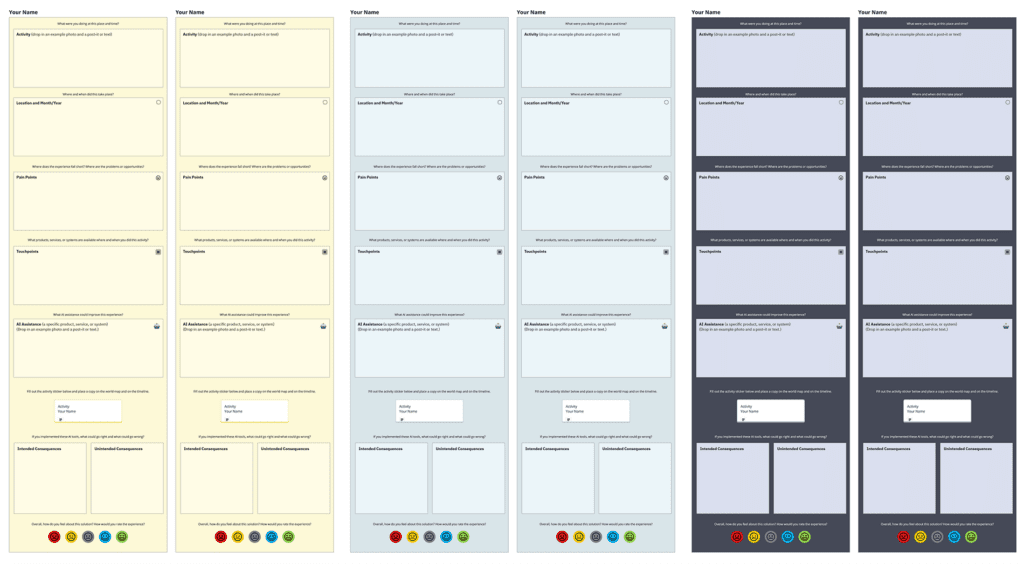
A single panel with all the assignment steps is shown below.

The activity sticker was a component students filled out and then used for the second part of the assignment.
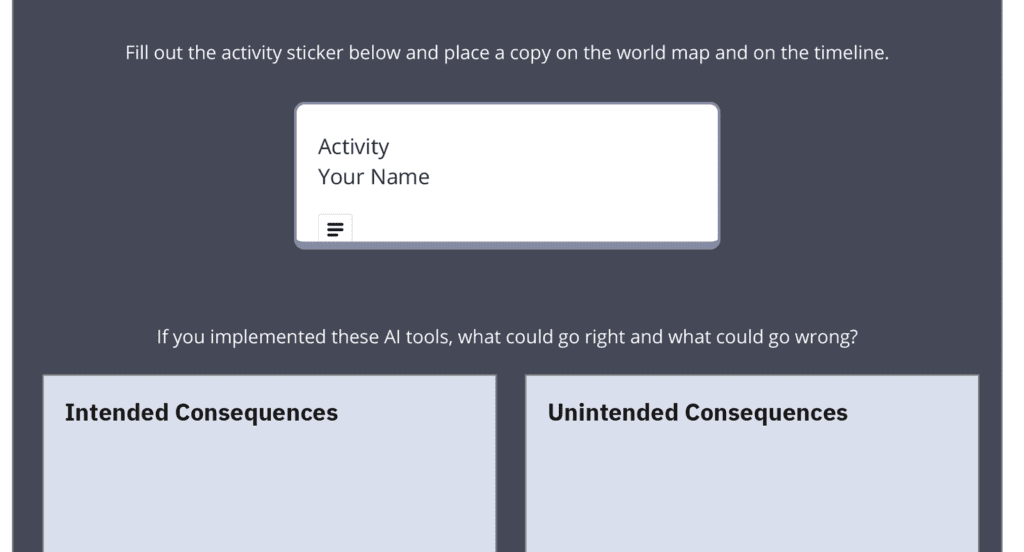
When students click on the activity sticker, a side panel expands in Miro, where they enter their daily activity details.
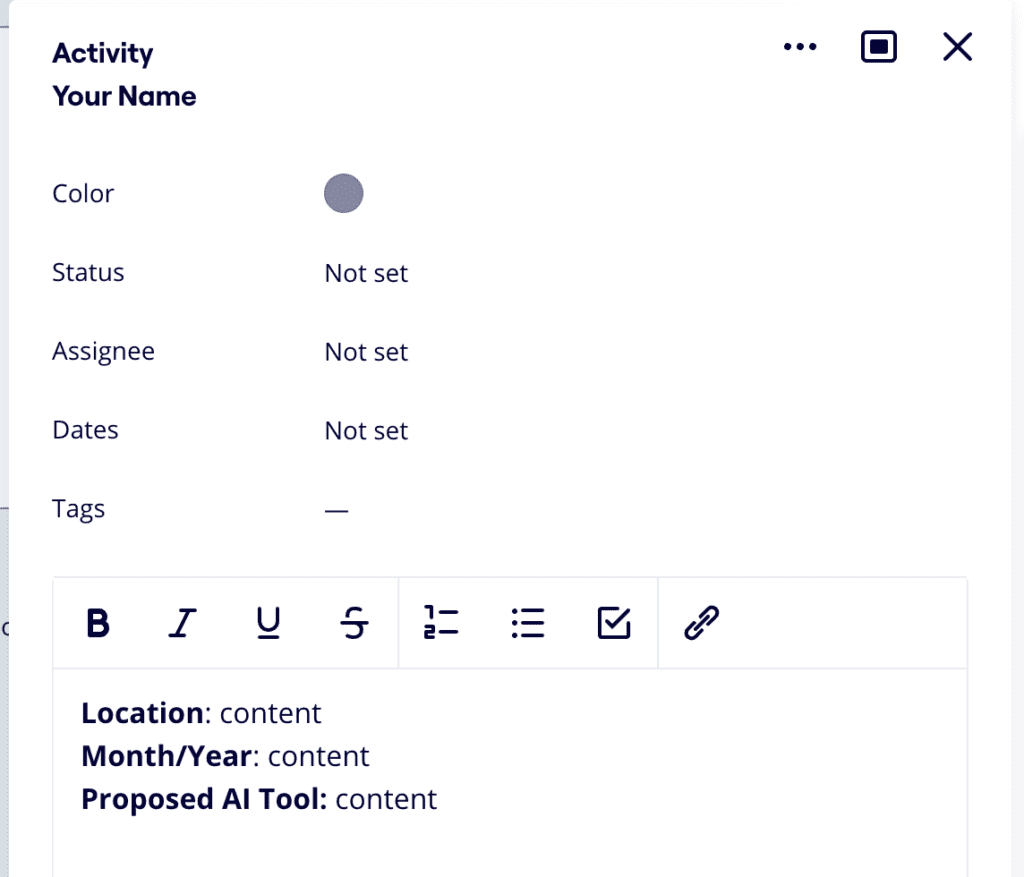
Putting the Everyday in Context
Because everyone’s “everyday” took place anywhere in the world and at different times, I invited students to place their activity sticker on a world map and on a timeline. We had a lot of fun seeing where the activity stickers would pop up on the map and during the day.
Below is the world map where students placed their activity stickers. (Thanks to the CIA World Factbook for the fantastic maps!)
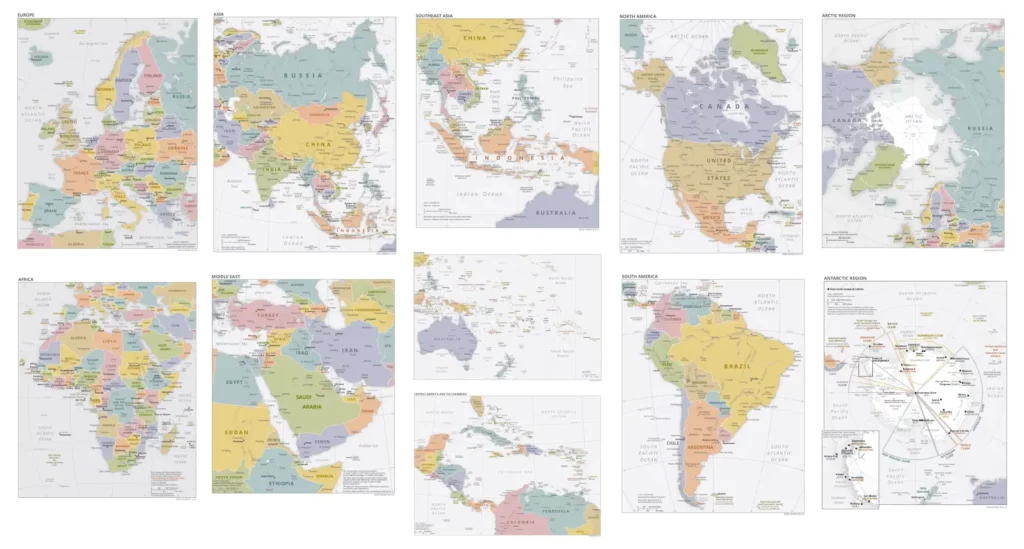
Students then placed a copy of their activity sticker on the day timeline so we could visualize what time of day each of these activities took place.
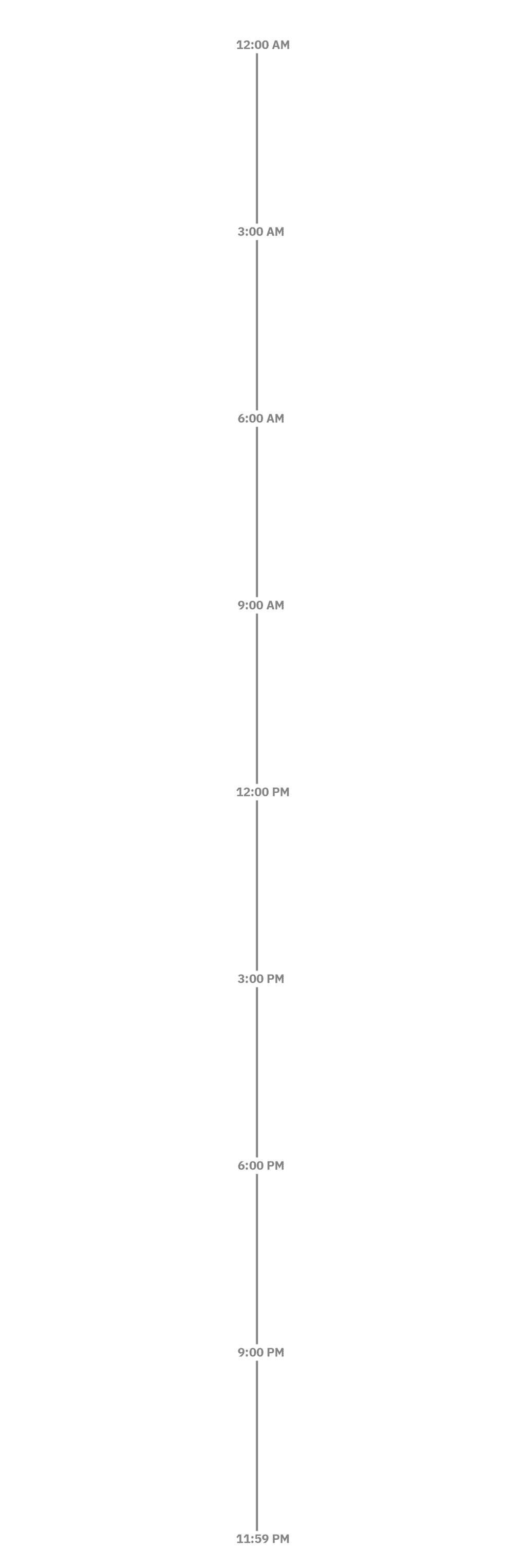
By the end of the three-day activity, the map and timeline were peppered with activities and ways AI tools could improve students’ lives in small but impactful ways.